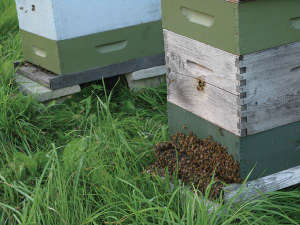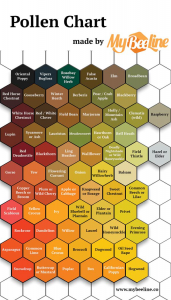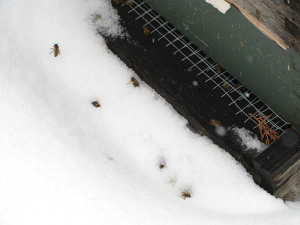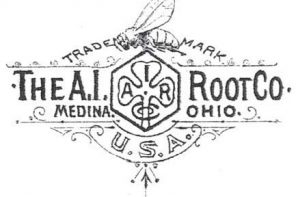By: Ross Conrad
 In the age of ubiquitous Varroa mites, potentially devastating small hive beetles, unpredictable weather patterns, rampant viral infections, nosema with minimal symptoms and antibiotic resistant American foulbrood, it is hard to exaggerate the importance of regular hive inspections. While a thorough and complete inspection cannot be conducted without opening up the hive, much can be deciphered prior to opening up a hive, by observing what is happening outside.
In the age of ubiquitous Varroa mites, potentially devastating small hive beetles, unpredictable weather patterns, rampant viral infections, nosema with minimal symptoms and antibiotic resistant American foulbrood, it is hard to exaggerate the importance of regular hive inspections. While a thorough and complete inspection cannot be conducted without opening up the hive, much can be deciphered prior to opening up a hive, by observing what is happening outside.
General activity level
One of the first and most obvious indications of the overall health and well-being of a colony can be deduced from simply observing the level of activity at the hive entrance. Generally speaking the more activity observed in front of the entrance, the better. When more than one hive is located in an apiary, it is fairly easy to tell which colonies are strong with a large population of bees and which are weak. The struggling colonies have less activity at the entrance than the stronger ones.
Swarming
Keep bees long enough and you’re bound to eventually come upon a hive with thousands of bees pouring out of it, even when additional room has been added in response to the bearding behavior (more on this below). The bees will all take to the air creating a huge humming cloud before usually settling down nearby to form a cluster. Thus, observations should not be restricted to just the hives, or even within the apiary. During the swarming season it is good to always look for “bees in the trees” all around the beeyard so there is a chance you can capture a new (old) colony, even if you miss their mass exodus.

The activity level outside of the hive can tell you a lot about the colony’s condition before you remove the cover and look inside.
Mating flights
Even rarer, though still within the realm of possibility, is seeing a queen bee at the hive entrance. A virgin queen will sit at the entrance, grooming herself by cleaning her antenna prior to taking off on her orientation or mating flights. Upon return from a successful mating flight, the tip of her abdomen will carry the remains of the reproductive organs of the last drone she mated with. Opportunities to spot a virgin queen are extremly limited and don’t expect to see her during inclement weather.
Balling the queen
Observing a small tight ball of bees near the hive entrance with a queen in its center is an another rare occurrence, one that I have only seen once in my 27 years of beekeeping. For one reason or another, when a queen is not desirable to a colony, she is forced out of the hive and (hopefully) replaced by the bees. Check back on such a hive within a couple weeks to be sure they are on the path to becoming queen-right.
Full Pollen Baskets
Bees carrying pollen into the hive packed onto their hind legs indicates a couple things. First it means that the bees are raising brood. Whether the brood is worker or drone, or both, will take opening up the hive and inspecting the brood nest. Pollen being brought into the hive also tells the beekeeper about the types of plants that are in bloom at the time.
Heavy loads
How the bees land at the entrance of the hive can reveal a lot about the amount of nectar being collected by foragers. While the average load is typically in the 20-40mg range, it is claimed that a worker bee can carry up to 100mg of nectar in its crop or honey stomach. (BIP 2011) The honey bee is normally very agile, but when weighed down with a heavy load, not so much. Foragers that land heavy on the landing board at the hive entrance and waddle slowly into the hive, or lose their grip when trying to land on a vertical surface by an upper hive entrance and fall down to the bottom board before heading inside are signs that the foragers are arriving with a heavy load, there are copious amounts of nectar being collected and the honey flow is on. Make sure the colony doesn’t run out of storage space.
Air conditioning
Another sign of a honey flow that is detectable without opening up the hive is the heavy smell of nectar stored in the honey comb being dehydrated and converted into honey. This is usually accompanied by dozens of bees at the hive entrance all lined up in the same direction fanning their wings intently. This coordinated movement of air through the colony can also be seen during periods of hot weather when the bees need to cool the interior of the hive in order to maintain the optimum brood rearing temperature of 94-95°F (34-35°C) and may be accompanied by bees bearding on the outside of the hive.
Bearding
When a colony has thousands of bees clustered on the outside of the hive creating a bee beard, it usually means one of two things. Either the colony is overheating and most of the hive’s inhabitants have moved outside in order to allow for greater air flow (and heat removal) from within the brood nest, or the hive is so crowded that there is little room inside for all the bees to fit comfortably. In both cases, the colony will likely benefit from additional room added to the hive, additional ventilation, or both and should be watched closely for signs of swarming.
Amount of honey in the hive Without opening the hive, the beekeeper can get a good feel for how much honey is in the hive by lifting up on one end of the bottom hive body. This “heft test” gives only a rough idea and unless the hive is impossible to lift, the hive will still have to be opened in order to more accurately assess and confirm the level of honey stored within the hive.
Smell
Most of the smells associated with beekeeping and bee hives are wonderfully pleasing: The sweet smell of honey; the vanilla scent of propolis; and the aromatic delight of beeswax. However there is one smell that is not so pleasing, the unpleasant smell of American foulbrood. If you are located in an area where goldenrod is abundant and in bloom, don’t confuse the musky sour smell of goldenrod nectar being converted into honey with the foul smell of AFB.
Sound
When inspecting a colony, do not overlook your sense of hearing. The sounds that emanate from a hive can tell you whether the colony is alive, such as a gentle hum of a colony clustered up during Winter, or in the process of raising a new queen which is often accompanied by the piping of new queens.
Refuse out front
Hive detritus scattered about on the ground in front of the hive entrance can provide an indication of the colony’s condition.
Dead bees are normal at certain times of the year such as late Winter, but can be a tell-tale warning sign at other times of the season. Look at the condition of the dead bees. Are the wings shriveled and deformed? Think Varroa. Do the dead bees all have their tongues sticking out? Think pesticides. Are the bodies of the bees half eaten? A mouse or other scavenger has gotten there before you and eaten the evidence.
Chalk brood mummies are commonly found lying near the entrance of infected hives as housecleaning worker bees perform their work. Meanwhile, dead larvae and pupae may be dragged from the hive after suffering chill brood or harm from treatments for diseases or pests like Varroa. Grass matted down in front of the hive and droppings that resembles cat feces with bits of honey bees in it, are a sign that skunks have been feeding on the bees in your hive. The number of clues to a colonies state of health and wellbeing that can be found simply by looking at the dead bees by the hive entrance are astounding. Take the time to look closely.

Pollen being brought into the hive is a sign of brood rearing. This pollen chart will help you identify which plants the bee pollen has been gathered from by matching the color of the pollen with the color on the chart. MyBeeLine – www.mybeeline.co
Robbing
Finding small pieces of wax cappings in or around the hive entrance? It could be a sign that the colony is being robbed out by others. Additional clues that may indicate the presence of robbing behavior are overly aggressive guard bees and the hive is light on honey (see heft test above).
A colony being robbed of its honey can easily be mistaken for a strong hive simply due to the amount of bee activity at the hive entrance. Look closely at the flight activity of the worker bees flying in and around the hive. Robbing bees will hover around the entrance with numerous quick, jerky motions before they land. This behavior is quite different from a returning forager that belongs to the hive, as they will tend to fly in a more direct path, land and then calmly walk into the hive without much resistance or challenge from guard bees at the entrance. If you suspect robbing, the first thing you should do is reduce the size of the hive entrance, and then check to see if the colony has enough food or whether it needs to be fed.
Orientation flights
Another event that will result in a lot of activity outside the entrance of the hive is when a large number of young bees all reach the age when they transition to become foragers at around the same time. Young bees making their first orientation flights outside the hive can look a bit like robber bees, as they all face the hive entrance and hover back and forth in front of the hive, sometimes landing by the hive entrance and then taking to the air again as they learn to recognize their home. Look for some of the other indications to be sure what you think may be orientation flights really are not robbers.
Note the time of day you see this, too. Early morning, even up to lunch time is too early for these flights. They are mid to late afternoon activities.
Although there is much one can determine about the state of a colony without opening the hive, external inspections cannot definitively tell you all that much. Ultimately external inspections are NOT a substitute for opening up the hive in most instances. Inspecting the conditions outside a hive is simply part of a full inspection and can help save the beekeeper valuable time by providing an idea of what to look for once the hive cover is removed.







